2017 FIAT 500L LIVING window
[x] Cancel search: windowPage 8 of 240
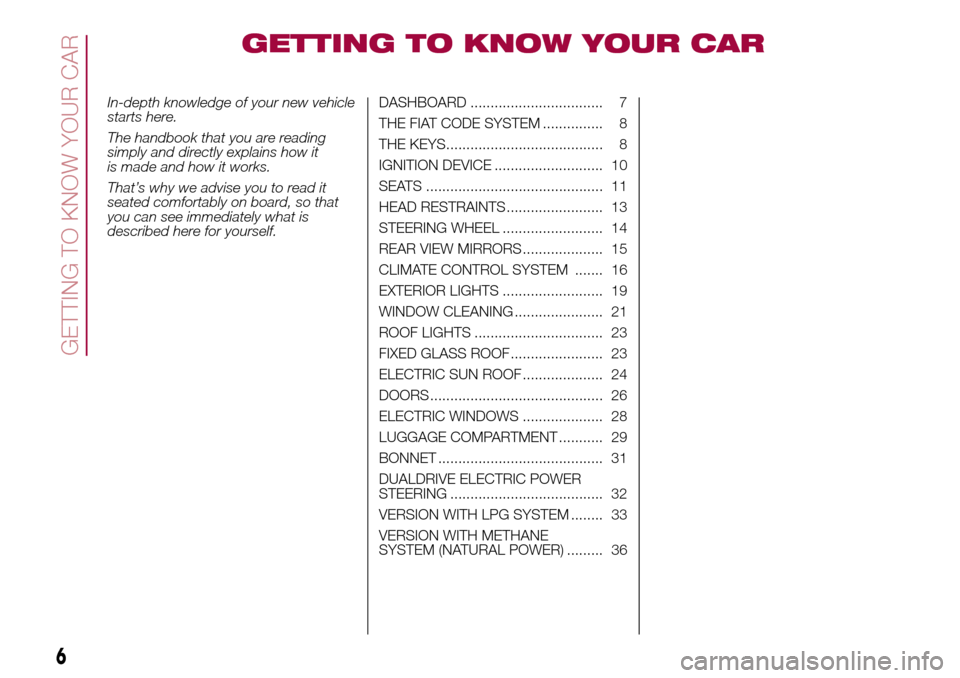
GETTING TO KNOW YOUR CAR
In-depth knowledge of your new vehicle
starts here.
The handbook that you are reading
simply and directly explains how it
is made and how it works.
That’s why we advise you to read it
seated comfortably on board, so that
you can see immediately what is
described here for yourself.DASHBOARD ................................. 7
THE FIAT CODE SYSTEM ............... 8
THE KEYS....................................... 8
IGNITION DEVICE ........................... 10
SEATS ............................................ 11
HEAD RESTRAINTS ........................ 13
STEERING WHEEL ......................... 14
REAR VIEW MIRRORS .................... 15
CLIMATE CONTROL SYSTEM ....... 16
EXTERIOR LIGHTS ......................... 19
WINDOW CLEANING ...................... 21
ROOF LIGHTS ................................ 23
FIXED GLASS ROOF ....................... 23
ELECTRIC SUN ROOF .................... 24
DOORS ........................................... 26
ELECTRIC WINDOWS .................... 28
LUGGAGE COMPARTMENT ........... 29
BONNET ......................................... 31
DUALDRIVE ELECTRIC POWER
STEERING ...................................... 32
VERSION WITH LPG SYSTEM ........ 33
VERSION WITH METHANE
SYSTEM (NATURAL POWER) ......... 36
6
GETTING TO KNOW YOUR CAR
Page 9 of 240
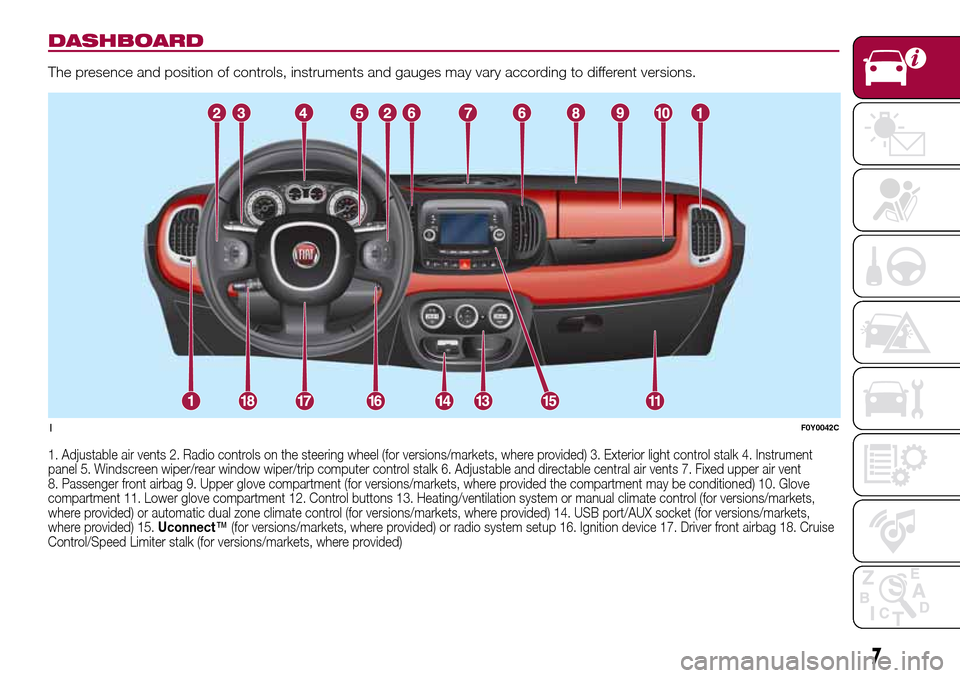
DASHBOARD
The presence and position of controls, instruments and gauges may vary according to different versions.
1. Adjustable air vents 2. Radio controls on the steering wheel (for versions/markets, where provided) 3. Exterior light control stalk 4. Instrument
panel 5. Windscreen wiper/rear window wiper/trip computer control stalk 6. Adjustable and directable central air vents 7. Fixed upper air vent
8. Passenger front airbag 9. Upper glove compartment (for versions/markets, where provided the compartment may be conditioned) 10. Glove
compartment 11. Lower glove compartment 12. Control buttons 13. Heating/ventilation system or manual climate control (for versions/markets,
where provided) or automatic dual zone climate control (for versions/markets, where provided) 14. USB port/AUX socket (for versions/markets,
where provided) 15.Uconnect™(for versions/markets, where provided) or radio system setup 16. Ignition device 17. Driver front airbag 18. Cruise
Control/Speed Limiter stalk (for versions/markets, where provided)
1F0Y0042C
7
Page 11 of 240
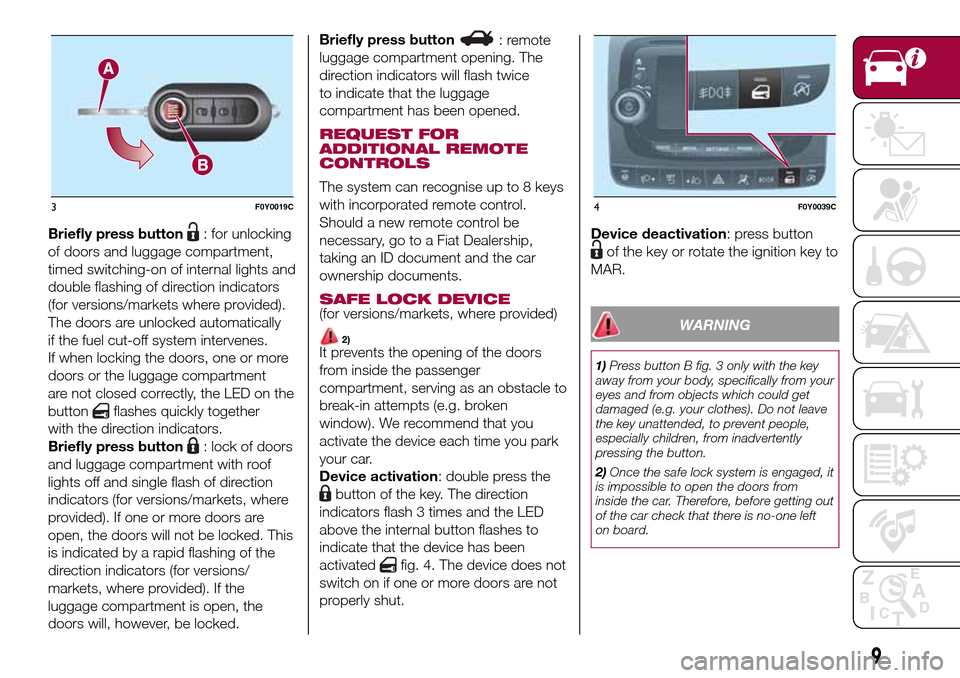
Briefly press button: for unlocking
of doors and luggage compartment,
timed switching-on of internal lights and
double flashing of direction indicators
(for versions/markets where provided).
The doors are unlocked automatically
if the fuel cut-off system intervenes.
If when locking the doors, one or more
doors or the luggage compartment
are not closed correctly, the LED on the
button
flashes quickly together
with the direction indicators.
Briefly press button
: lock of doors
and luggage compartment with roof
lights off and single flash of direction
indicators (for versions/markets, where
provided). If one or more doors are
open, the doors will not be locked. This
is indicated by a rapid flashing of the
direction indicators (for versions/
markets, where provided). If the
luggage compartment is open, the
doors will, however, be locked.Briefly press button
: remote
luggage compartment opening. The
direction indicators will flash twice
to indicate that the luggage
compartment has been opened.
REQUEST FOR
ADDITIONAL REMOTE
CONTROLS
The system can recognise up to 8 keys
with incorporated remote control.
Should a new remote control be
necessary, go to a Fiat Dealership,
taking an ID document and the car
ownership documents.
SAFE LOCK DEVICE(for versions/markets, where provided)
2)It prevents the opening of the doors
from inside the passenger
compartment, serving as an obstacle to
break-in attempts (e.g. broken
window). We recommend that you
activate the device each time you park
your car.
Device activation: double press the
button of the key. The direction
indicators flash 3 times and the LED
above the internal button flashes to
indicate that the device has been
activated
fig. 4. The device does not
switch on if one or more doors are not
properly shut.Device deactivation: press button
of the key or rotate the ignition key to
MAR.
WARNING
1)Press button B fig. 3 only with the key
away from your body, specifically from your
eyes and from objects which could get
damaged (e.g. your clothes). Do not leave
the key unattended, to prevent people,
especially children, from inadvertently
pressing the button.
2)Once the safe lock system is engaged, it
is impossible to open the doors from
inside the car. Therefore, before getting out
of the car check that there is no-one left
on board.
3F0Y0019C4F0Y0039C
9
Page 18 of 240
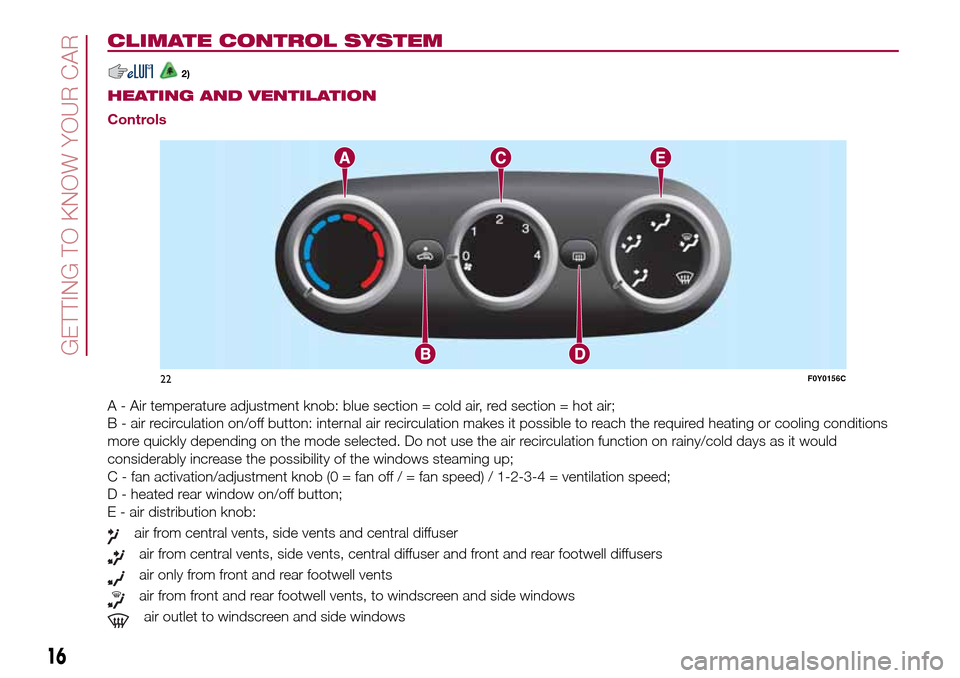
CLIMATE CONTROL SYSTEM
2).
HEATING AND VENTILATION
Controls
A - Air temperature adjustment knob: blue section = cold air, red section = hot air;
B - air recirculation on/off button: internal air recirculation makes it possible to reach the required heating or cooling conditions
more quickly depending on the mode selected. Do not use the air recirculation function on rainy/cold days as it would
considerably increase the possibility of the windows steaming up;
C - fan activation/adjustment knob (0 = fan off / = fan speed) / 1-2-3-4 = ventilation speed;
D - heated rear window on/off button;
E - air distribution knob:
air from central vents, side vents and central diffuser
air from central vents, side vents, central diffuser and front and rear footwell diffusers
air only from front and rear footwell vents
air from front and rear footwell vents, to windscreen and side windows
air outlet to windscreen and side windows
22F0Y0156C
16
GETTING TO KNOW YOUR CAR
Page 19 of 240
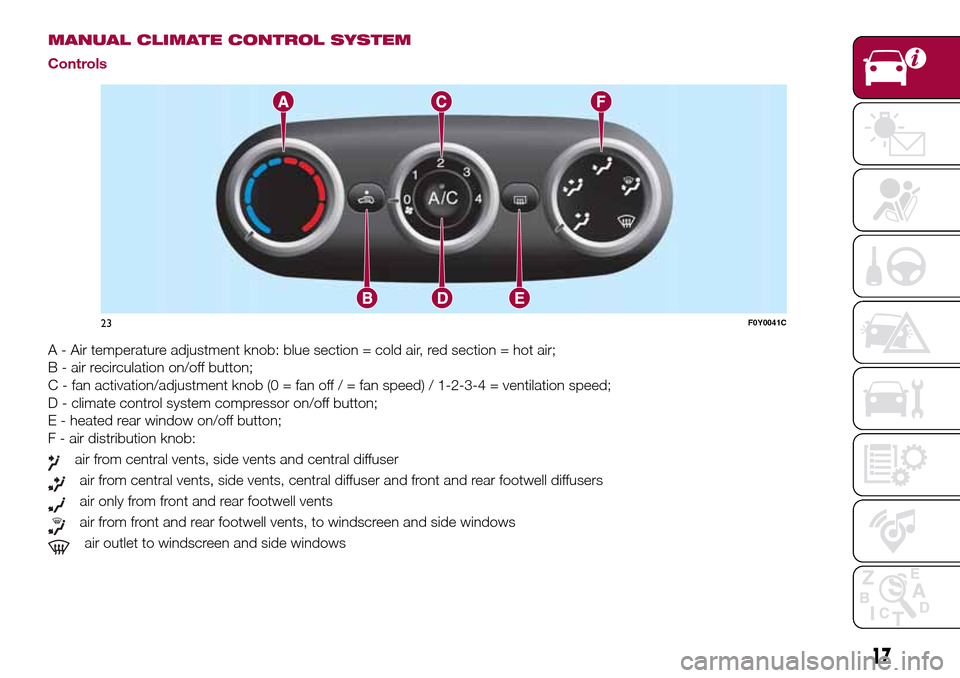
MANUAL CLIMATE CONTROL SYSTEM
Controls
A - Air temperature adjustment knob: blue section = cold air, red section = hot air;
B - air recirculation on/off button;
C - fan activation/adjustment knob (0 = fan off / = fan speed) / 1-2-3-4 = ventilation speed;
D - climate control system compressor on/off button;
E - heated rear window on/off button;
F - air distribution knob:
air from central vents, side vents and central diffuser
air from central vents, side vents, central diffuser and front and rear footwell diffusers
air only from front and rear footwell vents
air from front and rear footwell vents, to windscreen and side windows
air outlet to windscreen and side windows
23F0Y0041C
17
Page 20 of 240
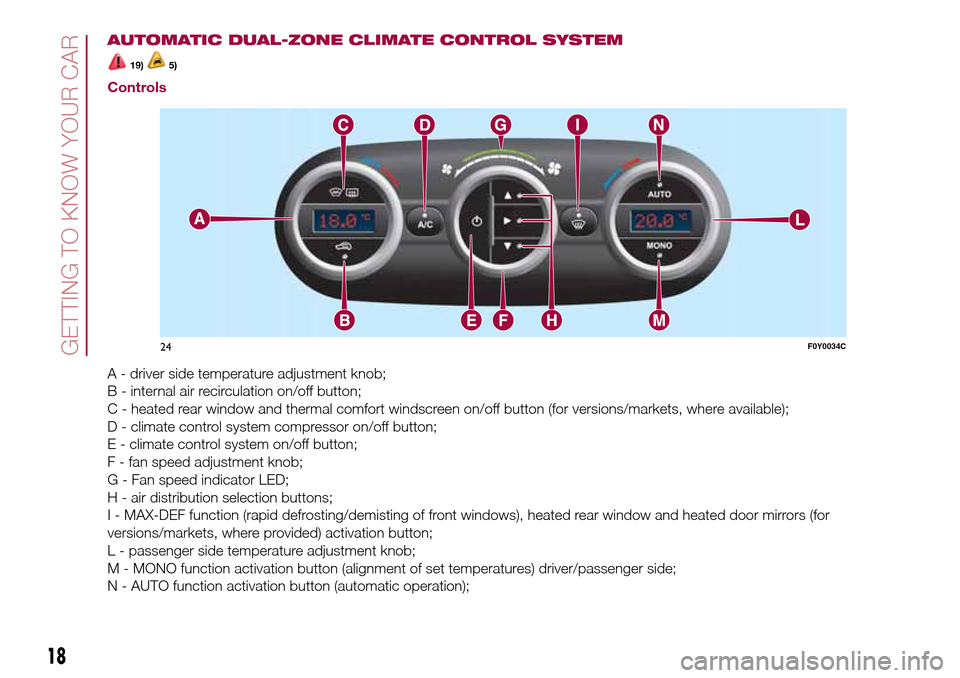
AUTOMATIC DUAL-ZONE CLIMATE CONTROL SYSTEM
19)5)
Controls
A - driver side temperature adjustment knob;
B - internal air recirculation on/off button;
C - heated rear window and thermal comfort windscreen on/off button (for versions/markets, where available);
D - climate control system compressor on/off button;
E - climate control system on/off button;
F - fan speed adjustment knob;
G - Fan speed indicator LED;
H - air distribution selection buttons;
I - MAX-DEF function (rapid defrosting/demisting of front windows), heated rear window and heated door mirrors (for
versions/markets, where provided) activation button;
L - passenger side temperature adjustment knob;
M - MONO function activation button (alignment of set temperatures) driver/passenger side;
N - AUTO function activation button (automatic operation);
24F0Y0034C
18
GETTING TO KNOW YOUR CAR
Page 21 of 240
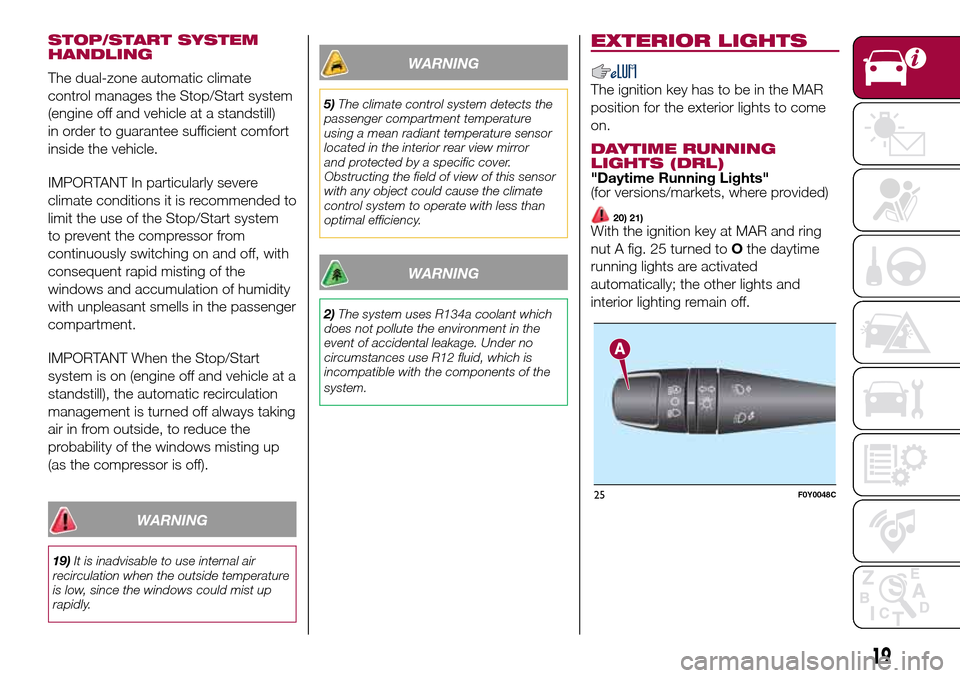
STOP/START SYSTEM
HANDLING
The dual-zone automatic climate
control manages the Stop/Start system
(engine off and vehicle at a standstill)
in order to guarantee sufficient comfort
inside the vehicle.
IMPORTANT In particularly severe
climate conditions it is recommended to
limit the use of the Stop/Start system
to prevent the compressor from
continuously switching on and off, with
consequent rapid misting of the
windows and accumulation of humidity
with unpleasant smells in the passenger
compartment.
IMPORTANT When the Stop/Start
system is on (engine off and vehicle at a
standstill), the automatic recirculation
management is turned off always taking
air in from outside, to reduce the
probability of the windows misting up
(as the compressor is off).
WARNING
19)It is inadvisable to use internal air
recirculation when the outside temperature
is low, since the windows could mist up
rapidly.
WARNING
5)The climate control system detects the
passenger compartment temperature
using a mean radiant temperature sensor
located in the interior rear view mirror
and protected by a specific cover.
Obstructing the field of view of this sensor
with any object could cause the climate
control system to operate with less than
optimal efficiency.
WARNING
2)The system uses R134a coolant which
does not pollute the environment in the
event of accidental leakage. Under no
circumstances use R12 fluid, which is
incompatible with the components of the
system.
EXTERIOR LIGHTS
The ignition key has to be in the MAR
position for the exterior lights to come
on.
DAYTIME RUNNING
LIGHTS (DRL)
"Daytime Running Lights"
(for versions/markets, where provided)
20) 21)With the ignition key at MAR and ring
nut A fig. 25 turned toOthe daytime
running lights are activated
automatically; the other lights and
interior lighting remain off.
25F0Y0048C
19
Page 23 of 240
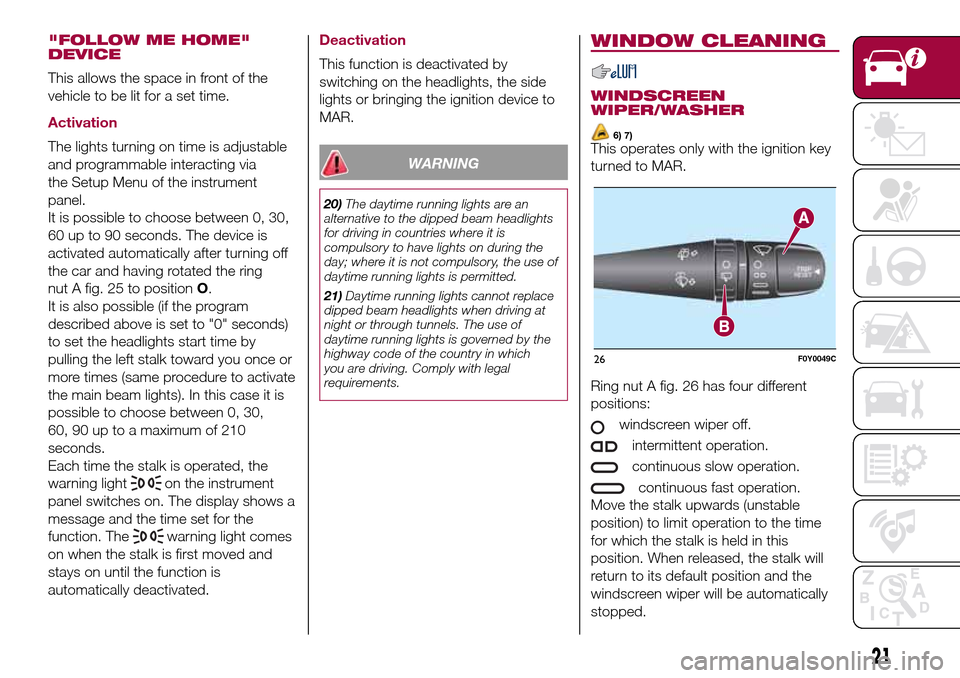
"FOLLOW ME HOME"
DEVICE
This allows the space in front of the
vehicle to be lit for a set time.
Activation
The lights turning on time is adjustable
and programmable interacting via
the Setup Menu of the instrument
panel.
It is possible to choose between 0, 30,
60 up to 90 seconds. The device is
activated automatically after turning off
the car and having rotated the ring
nut A fig. 25 to positionO.
It is also possible (if the program
described above is set to "0" seconds)
to set the headlights start time by
pulling the left stalk toward you once or
more times (same procedure to activate
the main beam lights). In this case it is
possible to choose between 0, 30,
60, 90 up to a maximum of 210
seconds.
Each time the stalk is operated, the
warning light
on the instrument
panel switches on. The display shows a
message and the time set for the
function. The
warning light comes
on when the stalk is first moved and
stays on until the function is
automatically deactivated.
Deactivation
This function is deactivated by
switching on the headlights, the side
lights or bringing the ignition device to
MAR.
WARNING
20)The daytime running lights are an
alternative to the dipped beam headlights
for driving in countries where it is
compulsory to have lights on during the
day; where it is not compulsory, the use of
daytime running lights is permitted.
21)Daytime running lights cannot replace
dipped beam headlights when driving at
night or through tunnels. The use of
daytime running lights is governed by the
highway code of the country in which
you are driving. Comply with legal
requirements.
WINDOW CLEANING
WINDSCREEN
WIPER/WASHER
6) 7)This operates only with the ignition key
turned to MAR.
Ring nut A fig. 26 has four different
positions:
windscreen wiper off.
intermittent operation.
continuous slow operation.
continuous fast operation.
Move the stalk upwards (unstable
position) to limit operation to the time
for which the stalk is held in this
position. When released, the stalk will
return to its default position and the
windscreen wiper will be automatically
stopped.
26F0Y0049C
21